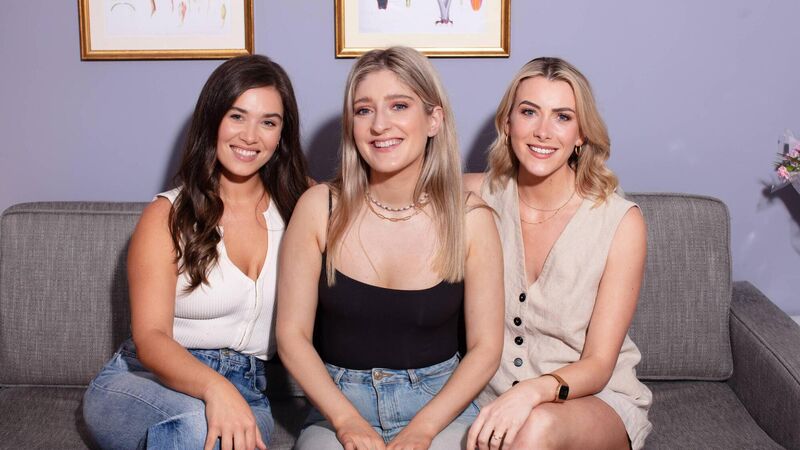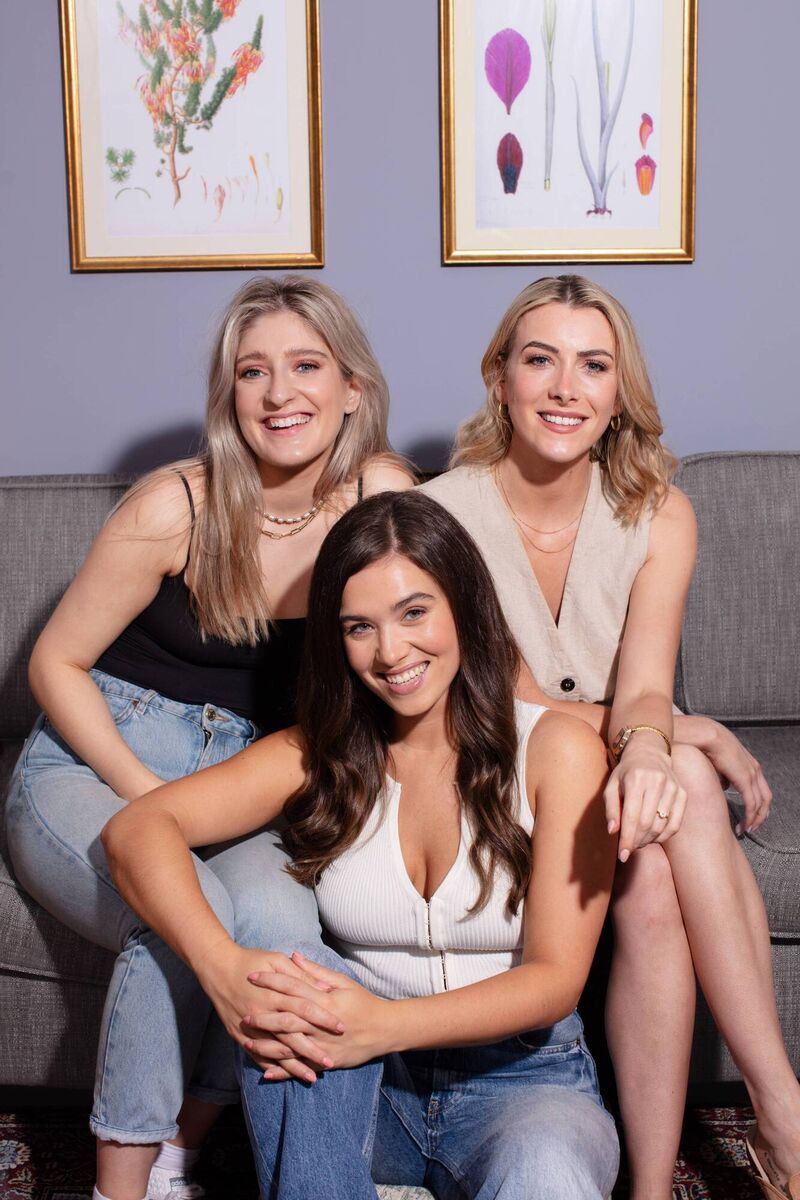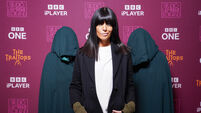How to Gael Podcast: ‘We’re just three friends who happen to be Gaeilgeoirs’

How to Gael with Síomha Ní Ruairc, Doireann Ní Ghlacáin and Louise Cantillon. Picture: Bríd O’ Donavan
One of the stand-out moments of Cillian Murphy’s Oscar award-winning speech earlier this month was his use of the cúpla focal and declaration of his pride in being Irish.
These days, it seems like everyone is ag baint usáid as a gcúpla focail.
And it’s not just the Irish language that’s in vogue.
All around the country, a wave of artists and changemakers are powering a cultural revival.
Music acts such as Lankum, the Mary Wallopers, Kneecap and John Francis Flynn; filmmakers such as Colm Bairéad and Seán Breathnach; actors such as Paul Mescal and Brendan Gleeson, comedians such as Áine Gallagher and Louisa Ní Éideáin; anti-establishment campaigns, such as ‘Save the Cobblestone’; and much more, are challenging our perceptions of what Irishness is.
In a Dublin apartment, three glamorous Gaeilgeoirs are putting their own spin on this.
Síomha Ní Ruairc, Louise Cantillon, and Doireann Ní Ghlacáin are co-hosts of How To Gael, a podcast launched in October that has been gaining word-of-mouth traction since.
Structured around a series of ‘How to …’ prompts (How to sort your shit out; How to stop scrolling; How to flirt) it’s a free-flowing chat between friends that’s funny, familiar, irreverent. It also happens to be bilingual.
Ní Ruairc, Cantillion, and Ní Ghlacáin met working for the Irish-language broadcaster, TG4, and all hail from Irish-speaking families.
On the podcast, as when they’re together off air, they see-saw between Irish and English, taking listeners along for chats about everything from having notions (involving oysters and champagne), to organising your fridge (Flora eaters need not apply), to being a bride-chill-a (Cantillon married her beau, Limerick All-Star Declan Hannon, last summer, while Ní Ruairc will tie the knot with her fiancé, mixed martial artist Cathal Pendred, this year).
As the blurb of the podcast suggests, “you will not learn the modh coinníollach on this pod”.
The idea is to engage with Gaeilge and what it means to be a Gael in a way that is more “bilingual bottomless brunch” than Leaving Cert Aural.
“Sometimes when you put something out in the Irish language, people will automatically be like: ‘if you’re doing your Leaving Cert as Gaeilge you should listen to this’,” says Ní Ghlacáin.
“We were conscious of this not becoming another ‘learning-the-language’ resource. We’re three friends. We talk about current things. And it just happens that we’re Gaeilgeoirs.”
Each of the three hosts has an impressive résumé in her own right.
Ní Ruairc, who many might recognise as the newest face of Virgin Media’s Ireland AM, has also hosted the likes of Grá ar an Trá (RTÉ’s bilingual answer to Love Island) and An Ríl Deal (TG4’s Irish-dancing competition).
Cantillon, who recently landed a role as Today FM’s weekday presenter, has previously worked for Spin Southwest and presented the likes of Junior Eurovision Éire.
And Ní Ghlacáin, perhaps best known as a fiddle player, is also an academic and TV host who wrote and presented the 2021 documentary, Seán Ó Riada — Mo Seanathair, about her grandfather, legendary composer, Seán Ó Riada.
'YOU'RE PART OF A TRIBE'
It was when Limerick-native Cantillon moved up to Dublin last year and went in search of “some girlos” for company, that the podcast was born.
“We’re all similar ages working in similar jobs and we decided to go on a night out in Dublin, just the three of us.
“When we are together, we naturally meander between Irish and English, so we were like: we should just record this.”
From its first episode, the podcast commits itself to the idea of being a Gael, that is, somebody who identifies with Gaelic culture, in a modern and historical sense.

For example, the How to Gael hosts love to quote the Brehon laws, a progressive legal system from medieval Ireland that recognised things such as equal rights
between genders and showed concern for the environment.
“Gael is kind of a concept like gender. It’s different to every person,” says Ní Ghlacáin.
“For me, the main message of it is that you’re part of a tribe that, in my mind, is very open-minded, very grámhar, a tribe that has probably suffered a lot of generational trauma, where our culture and way of life and language was suppressed.”
“What I hope we’re doing is making being a Gael very accessible to someone who feels maybe they can’t or don’t have enough Gaeilge,” says Cantillon. “Anyone can be a Gael, regardless of the amount of language you have.”
Ní Ruairc, who was born in Galway but raised in Lucan, Dublin, feels that there was “a mark” put on her growing up, because she spoke Irish at home, but that in recent times, attitudes seem to be changing.
“What I would hope is now, because we are such a multicultural society, is that it’s not as unusual for people to speak a different language at home.
“Hopefully the growth of multiculturalism in Ireland will grow the acceptance of Irish culture as well.”
'KICK THAT FEAR'
And while the ‘Gael’ aspect of the podcast is interesting, most people will find themselves tuning in for their fix of ‘girlo chats’.
The episodes are lively, free-flowing affairs that can end up as quite revelatory.
“When we started, we were speaking to a couple thousand ears and that was it,” says Ní Ghlacáin. Now that it’s grown, they “have to be a bit careful”.
“I’m very loose,” says Cantillon with a laugh. “I’d be telling stories about my best friends’ secrets.”
Of course, not everyone has a perfect command of the Irish language.
Are non-Gaeilgeoirs excluded?
“You get a lot of people saying they’re picking up their understanding of [the Irish] from context clues, and even though they mightn’t know the exact words, they’re still familiarising themselves with the language,” says Ní Ruairc.
“I’ve got friends who wouldn’t speak Irish whatsoever and are listening to the podcast and saying they are picking up some words.”
The advice they give for those wishing to improve their Irish is, firstly, “get used to listening to it”.
“Avail of all the TV and radio and shows and wealth of stuff that’s out there,” says Ní Ruairc.
Cantillon, who began her career as a secondary school Irish teacher, says shedding self-consciousness and throwing a few words into conversation is key.
“For years, [what] always held me back [was] not having the confidence to speak it… you just have to kick that fear.
“Any few focail are better than nothing at all.”
Ní Ruairc thinks it’s important to shed the embarrassment that goes along with not being able to speak the language well enough.
“[People] feel this guilt that can turn into animosity towards the language when it’s not their fault they can’t speak it. It’s never been their fault.
“The system’s not made for people to come out speaking fluent Irish after 14 years, unfortunately. But they can always create a new relationship with the language.
“People say, ‘well, I hated it in school.’ It’s like, well, that’s fine because that’s one subject you did one hour a day…
“It’s actually a living language and you can recreate a brand new, positive relationship with it whenever you want.”
The podcast’s lightning-fast success shows many people agree.
After the interview, it’s off to record an episode and release a secret they’ve been keeping: they’re bringing How To Gael to a live audience.
“It’s called How To Gael: Ar An mBóthar,” says Cantillon.
“There will be a few surprises thrown in. It’s a great bilingual night.
“If you’re someone who wants an excuse to talk more Irish or somewhere to go or someone to meet, this is the night, we are your people.”
- How to Gael is available wherever you get your podcasts. Tickets for ‘How To Gael: Ar An mBóthar’, April 8 in Liberty Hall Theatre, Dublin are on sale from ticketmaster.ie


